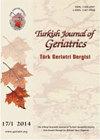球囊后凸成形术治疗骨质疏松性椎体骨折对脊柱平衡的影响
IF 0.3
4区 医学
Q4 GERIATRICS & GERONTOLOGY
Turkish Journal of Geriatrics-Turk Geriatri Dergisi
Pub Date : 2023-06-01
DOI:10.29400/tjgeri.2023.344
引用次数: 0
摘要
骨质疏松性椎体骨折和脊柱退变是衰老的常见后果,这两种病理的共同发生会损害脊柱平衡,导致进一步畸形的发展。骨质疏松性椎体骨折最常见的治疗措施是经皮球囊后凸成形术,可以潜在地改善沿矢状面和冠状面脊柱平衡。然而,迄今为止,支持这一问题的证据有限。材料与方法:本研究纳入49例确诊为骨质疏松性椎体骨折的患者(男性27例,女性22例)。术前和术后1年采用三维胸腰椎计算机断层扫描对患者进行评估。矢状面采用腰椎前凸角和骶坡角评估,冠状面采用Cobb角评估。治疗前后的角度值进行了统计学比较。结果:研究参与者的平均年龄为72.16岁(范围:61-94岁),分别有28.6%和71.4%的患者出现胸椎和腰椎骨折。此外,19例患者出现自发性或轻微创伤性椎体骨折,16例诊断为退行性脊柱侧凸的患者在治疗后Cobb角明显改善。术前和术后平均骶骨斜率和腰椎前凸角的比较显示两者的值都增加了,这些差异虽然没有统计学意义,但与先前的文献一致。结论:经皮球囊后凸成形术可有效纠正脊柱失衡,已成为骨质疏松性椎体骨折的治疗手段。关键词:Kyphoplasty;骨质疏松症;脊柱骨折;姿势的平衡。本文章由计算机程序翻译,如有差异,请以英文原文为准。
EFFECT OF BALLOON KYPHOPLASTY TREATMENT FOR OSTEOPOROTIC VERTEBRAL FRACTURE ON SPINAL BALANCE
Introduction: Osteoporotic vertebral fractures and spinal degeneration are common consequences of aging, and co-occurrence of these two pathologies can impair spinal balance leading to development of further deformities. The most common treatment measure for osteoporotic vertebral fractures is percutaneous balloon kyphoplasty which can potentially improve spinal balance along the sagittal and coronal planes. However, there is limited evidence in support of this issue to date. Materials and Methods: This study included 49 patients (27 males, 22 females) who were diagnosed with osteoporotic vertebral fracture. The patients were evaluated preoperatively and one year postoperatively using three-dimensional thoracolumbar computed tomography scans. The lumbar lordosis and sacral slope angle were used to assess the sagittal plane, while coronal plane assessment was carried out using Cobb’s angle. The angle values before and after treatment were compared statistically. Results: The mean age of the study participants was 72.16 years (range: 61–94 years), and 28.6% and 71.4% of the patients exhibited thoracic and lumbar vertebral fractures, respectively. Moreover, 19 patients exhibited spontaneous or minor traumatic vertebral fractures, and 16 patients diagnosed with degenerative scoliosis exhibited a significant improvement in Cobb’s angle after treatment. The comparison of pre-and postoperative mean sacral slope and lumbar lordosis angles showed an increase in both values and these differences, although not statistically significant, in agreement with previous literature. Conclusion: Percutaneous balloon kyphoplasty has become an increasingly popular treatment measure for osteoporotic vertebral fracture due to its ability to effectively correct spinal imbalance in patients. Keywords: Kyphoplasty; Osteoporosis; Spinal Fractures; Postural Balance.
求助全文
通过发布文献求助,成功后即可免费获取论文全文。
去求助
来源期刊

Turkish Journal of Geriatrics-Turk Geriatri Dergisi
GERIATRICS & GERONTOLOGY-
CiteScore
0.60
自引率
0.00%
发文量
46
审稿时长
6-12 weeks
期刊介绍:
Turkish Journal of Geriatrics is a peer-reviewed journal. Official language of the journal is English. Turkish Journal of Geriatrics invites submission of Original Articles based on clinical and laboratory studies. Review Articles are published only after the invitation from the Editorial Board.
 求助内容:
求助内容: 应助结果提醒方式:
应助结果提醒方式:


